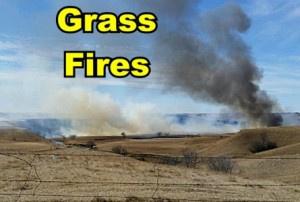 Bismarck The North Dakota Forest Service reports that on Friday, Apr 17, all of the state of North Dakota has high fire danger or very high fire danger according to the Fire Danger Map. The Fire Danger Rating is issued by the Missoula Fire Sciences Laboratory daily around 600 AM CDT (500 AM MDT) for each of North Dakota’s 53 counties.
Bismarck The North Dakota Forest Service reports that on Friday, Apr 17, all of the state of North Dakota has high fire danger or very high fire danger according to the Fire Danger Map. The Fire Danger Rating is issued by the Missoula Fire Sciences Laboratory daily around 600 AM CDT (500 AM MDT) for each of North Dakota’s 53 counties.
High fire danger means that all fine dead fuels ignite readily and fires start easily from most causes. Unattended brush and campfires are likely to escape. Fires spread rapidly and short-distance spotting is common. High-intensity burning may develop on slopes or in concentrations of fine fuels. Fires may become serious and their control difficult unless they are attacked successfully while small.
Very high fire danger means that fires start easily from all causes and, immediately after ignition, spread rapidly and increase quickly in intensity. Spot fires are a constant danger. Fires burning in light fuels may quickly develop high intensity characteristics such as long-distance spotting and fire whirlwinds when they burn into heavier fuels.
This Fire Danger Rating is issued once each day. The Fire Danger Rating is a forecast of the potential for non-agricultural grasslands to carry fire. It provides an indication of fire potential for grasslands, including its ability to spread. The rating contains five levels: Low, Moderate, High, Very High, and Extreme. Should a fire ignite, it is more likely that it would grow or spread during higher rating days. Many burn bans have also been issued across the state. To see current burn bans and check the daily Fire Danger Rating Map, check the NDResponse website at https://ndresponse.gov/burn-ban-restrictions-fire-danger-maps.
In 2019, 6,302 acres were reported as burned by wildfires in the state of North Dakota. Out of 484 wildfires, 463 were caused by humans and were preventable. Leading causes of preventable wildfires in the state of North Dakota in 2019 were debris burning (223 wildfires started), equipment use (70 wildfires started), and smoking (22 wildfires started). The North Dakota Forest Service would like to remind you of your responsibility to prevent unwanted wildfires and what you can do to help.
Remember ABC – Always Be Careful with fire. To learn more about fire danger, visit the ND Response website at https://ndresponse.gov/ Please make sure that you are aware of the laws in place by the North Dakota Department of Environmental Quality regarding open burning. You can learn more about this by visiting their website https://deq.nd.gov/AQ/permitting/OpenBurning.aspx .
If you are towing something, such as a boat, remember to check that your chains are not dragging. Dragging chains can cause sparks, which can ignite a wildland fire. Also, be careful when driving on dry brush or grass. Hot exhaust pipes can also ignite wildland fires, which you may not even notice until it is too late.
Sparks from lawnmowers and power equipment do start wildfires. Be careful on hot, dry days, and be sure to get your equipment checked regularly. Mow before 10 a.m., but never when it’s windy or excessively dry. Remember that lawn mowers are designed to mow lawns, not weeds or dry grass. Metal lawnmower blades striking rocks can create sparks and start fires. Keep the exhaust system, spark arresters and engine in proper working order and free of carbon buildup. Use the recommended grade of fuel and don’t fill to the point of overflowing. When doing any yardwork or work outdoors with mechanical equipment, keep a shovel and a fire extinguisher handy.
To learn more about how you can prevent unwanted, human caused wildfires, visit the Smokey Bear website at https://smokeybear.com/en.












Comments are closed
Sorry, but you cannot leave a comment for this post.